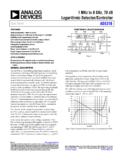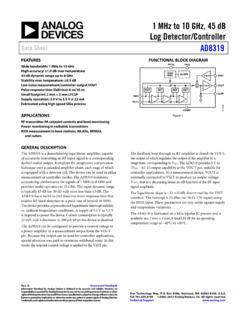Transcription of Steel Sheet Piling Design Manual - mcipin.com
1 Steel Sheet PilingDesign ManualUnited States SteelUpdated and reprinted by U. S. Department of Transportation /FHWA with 1984 Complete data regarding these sectionswill be found in a separate publicationentitled USS Steel Sheet Piling ?H-Homestead, Pa. (Pittsburgh District)S-South Chicago (Chicago District)Sections PS32 and PSA28 ate infre-quently rolled and we do not advise theiruse in a Design unless an adequate ton-nage can be ordered at one time to assurea minimum Allowable Design Stresses- Sheet PilingSteel Brand or GradeMinimum YieldPoint, psiAllowable Design Stress,psi*USS-EX-TEN 55 (ASTM A572 GR 55)USS EX-TEN 50 (ASTM A572 GR 50)USS MARINER STEELUSS EX-TEN 45 (ASTM A572 GR 45)Regular Carbon Grade (ASTM A 328)*Based on 65% of minimum yield point.
2 Some increase for temporary Overstressesgenerally Sheet PilingDesign ManualNotice The information, including technical and engineering data, figures, tables,designs, drawings, details, suggested procedures, and suggested specifications,presented in this publication are for general information only. While every ef-fort has been made to insure its accuracy, this information should not be usedor relied upon for any specific application without independent competentprofessional examination and verification of its accuracy, suitability andapplicability. Anyone making use of the material does so at his own risk andassumes any and all liability resulting from such use.
3 UNITED STATES STEELCORPORATION DISCLAIMS ANY AND ALL EXPRESS OR IMPLIED WARRANTIESOF MERCHANTABILITY FITNESS FOR ANY GENERAL OR PARTICULAR PURPOSEOR FREEDOM FROM INFRINGEMENT OF ANY PATENT, TRADEMARK, OR COPY-RIGHT IN REGARD TO INFORMATION OR PRODUCTS CONTAINED OR REFERREDTO HEREIN. Nothing herein contained shall be construed as granting a license,express or implied, under any patents. Notice by DOTThis document is disseminated under the sponsorship of the Department ofTransportation in the interest of information exchange. The United StatesGovernment assumes no liability for its contents or use thereof. The contentsof this report reflect the views of the USS, who is responsible for the accuracyof the data presented herein.
4 The contents do not necessarily reflect the offi-cial views or policy of the Department of Transportation. This report does notconstitute a standard, specification, or United States Government does not endorse products or or manufacturers names appear herein only because they are consid-ered essential to the object of this and reprintedby FHWA with permission, July,1984 USS and EX-TEN are registered trademarksTABLE OF CONTENTSUSS Steel Sheet Piling SectionsProfiles and Properties .. Inside Front CoverAllowable Design Stressesand Rankine Coefficients ..Inside Back CoverFOREWORD ..4 LATERAL PRESSURES ON Sheet PILE WALLS.
5 L ..5 Earth Pressure on Unbalanced Hydrostatic and Seepage Forces ..17 Other Lateral OF Sheet PILE RETAINING WALLS ..19 General Considerations ..19 Cantilever Sheet Piling in Granular Sheet Piling in Cohesive Walls .. Earth s Moment Reduction Earth Sheet Pile of Sheet Pile Walls .. Design OF ANCHORAGE SYSTEMS FOR Sheet PILE WALLS..Tie Rods ..Wales ..1414151516262627303335373940424242 Anchors ..44 Location of Pile Anchor Slab Design Based on Model Tests ..47 General Case in Granular Slab in Cohesive Tension OF COFFERDAMS FOR DEEP EXCAVATIONS.
6 56 General ..56 Lateral Pressure Distribution ..57 Sizing of Braced Cofferdam of Braced in Soft in COFFERDAMS ..68 General ..68 Circular of Cellular Design of Cofferdams on on Between Sheeting and Cell Failure on Centerline of Shear (Cummings Method)..75 Interlock on Deep Soil of Outer Face s Theory ..80 BIBLIOGRAPHY .. 83 Design EXAMPLES ..85 FOREWORDThis Manual is directed to the practicing engineer concerned with safe, economicaldesigns of Steel Sheet pile retaining structures. The content is directed basically towardthe designer s two primary objectives: overall stability of the structural system and theintegrity of its various is placed on step-by-step procedures for estimating the external forces on thestructure, evaluating the overall stability, and sizing the Sheet Piling and other structuralelements.
7 Graphs and tables are included to aid the designer in arriving at quick basic types of Sheet pile structures are considered: (3) cantilevered and anchoredretaining walls, (2) braced cofferdams and (3) cellular cofferdams. Consideration is alsogiven to the Design of anchorage systems for walls and bracing systems for Design procedures included in this Manual are in common use today by mostengineers involved in the Design of Sheet pile retaining structures. These methods haveconsistently provided successful retaining structures that have performed well in , in using these procedures, one should not be lulled into a false sense of securityabout the accuracy of the computed results.
8 This is especially true with regard to lateralearth pressures on retaining structures. The simplifying assumptions inherent in any ofthese procedures and their dependence on the strength properties of the soil provide onlyapproximations to is assumed throughout that the reader has a fundamental knowledge of soilmechanics and a working knowledge of structural Steel Design . It is further assumed thatthe subsurface conditions and soil properties at the site of the proposed construction havebeen satisfactorily established and the designer has-chosen the type of Sheet pile structurebest suited to the PRESSURES ON Sheet PILE WALLSEARTH PRESSURE THEORIESE arth pressure is the force per unit area exerted by the soil on the Sheet pile magnitude of the earth pressure depends upon the physical properties of the soil, theinteraction at the soil-structure interface and the magnitude and character of thedeformations in the soil-structure system.
9 Earth pressure is also influenced by thetime-dependent nature of soil strength, which varies due to creep effects and chemicalchanges in the pressure against a Sheet pile structure is not a unique function for each soil, butrather a function of the soil-structure system. Accordingly, movements of the structureare a primary factor in developing earth pressures. The problem, therefore, is stages of stress in the soil are of particular interest in the Design of Sheet pilestructures, namely the active and-passive states. When a vertical plane, such as a flexibleretaining wall, deflects under the action of lateral earth pressure, each element of soiladjacent to the wall expands laterally, mobilizing shear resistance in the soil and causing acorresponding reduction in the lateral earth pressure.
10 One might say that the soil tends tohold itself up by its boot straps; that is, by its inherent shear strength. The lowest state oflateral stress, which is produced when the full strength of the soil is activated (a state ofshear failure exists), is called the active state. The active state accompanies outwardmovement of the wall. On the other hand, if the vertical plane moves toward the soil,such as the lower embedded portion of a Sheet pile wall, lateral pressure will increase asthe shearing resistance of the soil is mobilized. When the full strength of the soil ismobilized, the passive state of stress exists. Passive stress tends to resist wall movementsand are two well-known classical earth pressure theories; the Rankine Theory and theCoulomb Theory.







